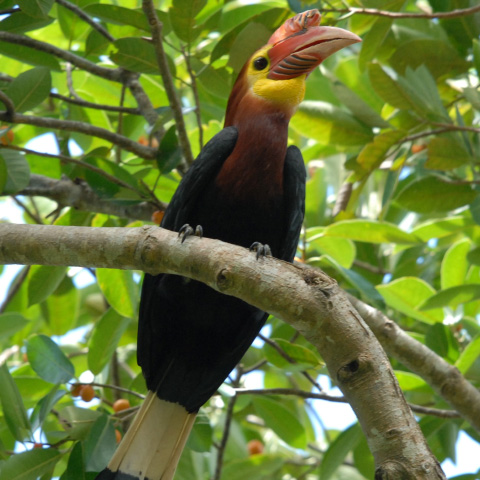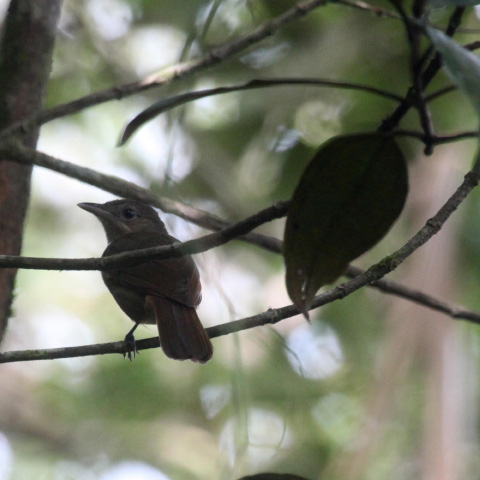Conservation Actions
Conservation Actions Underway
It has been recorded in protected areas in most range states (Bertram et al. 2020), potentially the most important being the Sundarbans (Sundarbans East Wildlife Sanctuary; Khan 2005), Bangladesh (Kochikhali Tiger Reserve; Thompson and Johnson 2003), Cambodia (Kulen Promtep Wildlife Sanctuary; Rous and Mahood 2017), Vietnam (Kon Cha Rang Nature Reserve) and the Chindwin Basin in northern Myanmar. It is depicted on conservation awareness material in Cambodia and Laos. The Hukaung Valley Tiger Reserve in Myanmar covers an area that is considered to be of high national and global significance for the species. The Sundarbans Finfoot Research Project has developed a breeding bird monitoring protocol in collaboration with the Bangladesh Forest Department (S. U. Chowdhury in litt. 2016).
Conservation Actions Proposed
Conduct extensive surveys to clarify its distribution, population status, breeding range and seasonal movements. Investigate its ecological requirements and tolerance of habitat degradation and disturbance. In order to further understand the population decline, regular monitoring of breeding birds should be conduced, e.g. in the Sundarbans, Bangladesh (S. Chowdhury in litt. 2016). Afford protected-area status to key breeding sites, and strictly minimise habitat loss, hunting and disturbance within them. Increase protected-area representation for riverine habitats throughout the range. Expand awareness-raising programmes in order to reduce pressure from hunting and egg collecting. Limit access to known breeding sites and temporarily restrict the use of mono-filament gillnets during the breeding season (Chowdhury et al. 2020).
Location Information
Heliopais personatus is patchily distributed across South-East Asia. The species's stronghold is assumed to be the Sundarbans in Bangladesh; further records come from Myanmar (Htamanthi Wildlife Sanctuary and Chindwin River Basin), Cambodia (Tonle Sap Lake, Kulen Promtep Wildlife Sanctuary, Chhep Wildlife Sanctuary and Cardamom Mountains), Viet Nam (Yok Don National Park and Kon Cha Rang Nature Reserve) and Laos (Xe Pian and Dong Kanthung National Biodiversity Conservation Areas) (Chowdhury et al. 2020 and references therein).
Its movements are poorly known; it appears to occur as a migrant in parts of the range. Breeding has been reported from Cambodia, while the species appears to be a non-breeding visitor to Malaysia and Sumatra and resident in the Sundarbans and Myanmar (Neumann-Denzau 2008, Chowdhury et al. 2020).
Populations are apparently in steep decline throughout its range such that the species has apparently disappeared from previously occupied sites, and likely also from some of the listed range countries. There are no recent records from its historical range in Assam and Arunachal Pradesh in north-eastern India; however large parts of the area are not well studied (Chowdhury et al. 2020). In Myanmar the last record on the Ayeyarwady River was in 2001, despite repeated survey (Zockler et al. 2020). Multiple records came from extensive surveys in 2003-05 in Kachin and Sagaing (Tordoff et al. 2007), leading to the conclusion that reasonable numbers persisted in the region. Despite regular field presence, camera-trapping and targeted bird surveys, there have been no further records since 2013 (Chowdhury et al. 2020). There are no recent (post 2000) records from Laos, and none from Viet Nam since 2002 (Chowdhury et al. 2020).
It is the same story for the non-breeding range. The species is only erratically recorded from Malaysia over the past decade, with very few records for at least five years. Likewise there are no records from Thailand since 2012 despite considerable search efforts (Chowdhury et al. 2020). Coverage in Malaysia has also increased in recent years, though remains erratic in the riparian areas the species may be using. The last record from Sumatra (Indonesia) dates from 2009, which itself was the first sighting in Indonesia for 16 years (M. Iqbal in litt. 2016).
Geographic Range
Extant
Bangladesh, Cambodia, Lao People's Democratic Republic, Myanmar, Viet Nam
Population Information
The species appears to have declined dramatically and is now known from comparatively few sites, occurring at low densities everywhere. Based on records compiled between 2008 and 2018 for the largest subpopulation in Bangladesh, supplemented with best-guesses derived from published, unpublished and anecdotal information for other sites, the total population is estimated to number 108-304 mature individuals in total (Chowdhury et al. 2020 and references therein). National population estimates include 80-160 mature individuals in the Sundarbans in Bangladesh, 12-64 mature individuals in Cambodia, 12-40 mature individuals in Myanmar, 4-30 mature individuals in Laos, 0-6 mature individuals in Viet Nam and 0-4 mature individuals in India (Chowdhury et al. 2020 and references therein). These values should however be treated with caution, as in parts of the range suitable habitat remains which has not been fully investigated (Chowdhury et al. 2020).
It is here assumed that the species forms several small subpopulations based on its localised distribution across South-East Asia: resident subpopulations in Bangladesh (80-160 mature individuals) and in Myanmar (12-40 mature individuals), and a presumed migratory population breeding in Cambodia, Laos and Viet Nam considered to function as one additional subpopulation of 16-100 mature individuals (Chowdhury et al. 2020).
Threats
The main threat is the destruction and increased levels of disturbance to rivers in lowland riverine forest, driven by agricultural clearance and logging operations and increased traffic on waterways. One-off incidents may also have affected some populations such as oil spills (D. Simic in litt. 2014). Habitats have been further degraded by the removal of bankside vegetation and changes in hydrology resulting from dam construction, and siltation. In Myanmar, gold mining along rivers is the major threat (N. M. Shwe in litt. 2020).-
Moreover, population declines in areas such as the Sundarbans may be directly or indirectly related to climate change; with the possible effects of climate change including frequent tropical cyclones, a decline in preferred nesting habitat due to lack to suitable trees (effected by salt water intrusion due to sea level rise and reduced freshwater influx), and lower density of prey species due to environmental changes such as saltwater intrusion and cyclone. The Sundarbans are further threatened with a proposed 1,320 Megawatt power station to be built 14 km away (Fowlie 2013).
Hunting and collection of eggs and chicks have been recorded and although their contribution to population declines is probably minimal this requires clarification (Neumann-Denzau 2008); indeed the species is easily caught at the nest making it prey to opportunistic human hunters, with 56% of interviewed fisherman having collected the species (adult, chick or egg) (S. Chowdhury in litt. 2016). The species is furthermore at risk of becoming tangled in mono-filament fishing nets, particularly in the Sundarbans (Chowdhury et al. 2020).
IUCN Red List Account Link
Please click here to see the species' IUCN Red List Account page.
Photo Credits
Sayam U Chowdhury
Bangladesh Environment and Development Society (BEDS)





